Shoot out: SMC Pentax-M 135mm f/3.5 vs. Canon nFD 135mm f/3.5 vs. Panagor PMC auto tele 135mm f/2.8
In my search for a compact but good budget telelens I came across the SMC Pentax-M 135mm f3.5 and the Canon newFD 135mm f/3.5. Later, I also found a Panagor PMC auto tele 135mm f/2.8 in Canon FD mount. These lenses are cheap, light, and small, but how do they perform?
Disclaimer: I only tested one sample of the Canon and Panagor, and two samples of the Pentax. Since these lenses are old there might be more sample variation than usual, other samples might perform slightly better or worse. Both Pentax samples displayed similar performance.
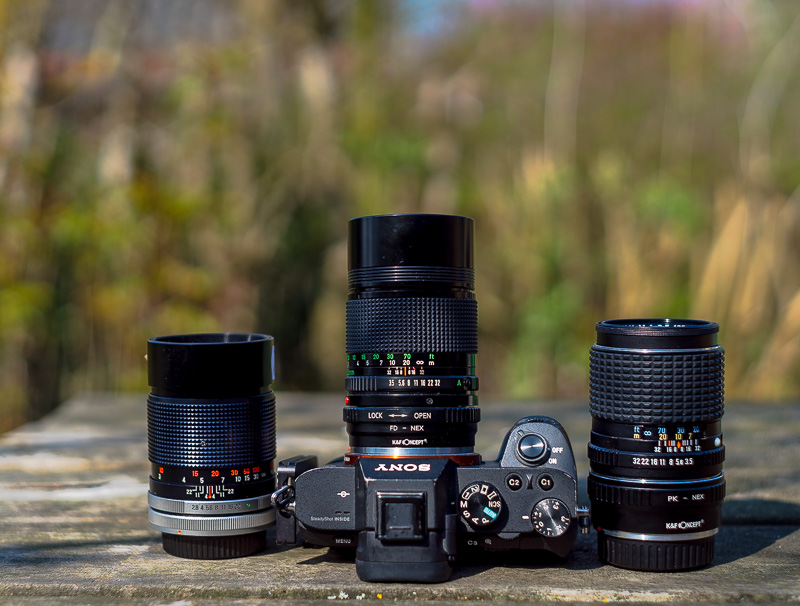
Specifications
| Specifications | Canon newFD 135mm f/3.5 | SMC Pentax-M 135mm f/3.5 | Panagor PMC auto tele 135mm f/2.8 (FD) |
| Diameter | 63 mm | 63 mm | 61 mm |
| Length | 85 mm | 66 mm | 88 mm |
| Filter diameter | 52 mm | 49 mm | 55 mm |
| Weight (ex. Adapter) | 325 g | 270 g | 411 g |
| Aperture | f/3.5-32 | f/3.5-32 | f/2.8-22 |
| Minimal focus distance | 1.3 m | 1.5 m | 1.5 m |
| Elements/groups | 4/4 | 5/5 | 4/4* |
| Aperture blades | 6 | 8 | 6 |
(*Based on the optical design of this lens for other mounts)
Versions and History

Canon newFD 135mm f/3.5
There are roughly two versions of the Canon 135mm f/3.5, a FD version and a newer newFD version, but there are three different versions of the older FD model. The first version of these is introduced in 1970 and consisted of 4 elements in 3 groups and had 8 aperture blades. The second version has been introduced in 1973 and has the same optical design but is slightly lighter, still has 8 aperture blades. The third version that consists of 4 elements in 4 groups is significantly lighter and has only 6 aperture blades. This latest version has been introduced in 1976. The older FD versions have the S.C. coating, the newFD version has the S.S.C. coating. The newFD version is quite a bit lighter, has 4 elements in 4 groups and has been introduced in 1979. More information can be found here and here.
Ebay.com* | Ebay.de*
(*Affiliate links, if you buy something via this link I will earn a small commission and it doen’t cost you anything extra 🙂 )
SMC Pentax-M 135mm f3.5
There are two versions of the SMC Pentax 135mm f/3.5, a plain SMC Pentax (introduced in 1975) and a SMC Pentax-M (introduced in 1977) version. The lens in the review is the latter one. The two lenses have a different optical design, and there is quite some difference in weight. The SMC Pentax weighs 365 grams and is 2.2 cm longer. I did not investigate whether one of these lenses performs better than the other. More information can be found here.
Ebay.com* | Ebay.de*
(*Affiliate links, if you buy something via this link I will earn a small commission and it doesn’t cost you anything extra 🙂 )
Panagor PMC auto tele 135mm f/2.8
I could not find much information about this lens. It has been produced in various mounts and there seem to be at least two optical designs, 4/4 and 4/2 (elements/groups). The lens tested in the review has 6 blades and FD mount. Furthermore there seems to be a version with 8 aperture blades. As information on the re-branded third party lenses is very scarce and strongly depends on the actual manufacturer I didn’t invest too much time in my research, if you have additional information please share in the comment section 🙂
Ebay.com* | Ebay.de*
(*Affiliate links, if you buy something via this link I will earn a small commission and it doen’t cost you anything extra 🙂 )
Build quality and handling
Canon newFD 135mm f/3.5
Compared to cheaper modern lenses made mostly from lower grade plastics build quality is very good, but compared to the very best manual lenses build quality is less nice. Nevertheless the lens feels much more solid than the newFD 50 mm f/1.8. The focus ring is made of metal with a plastic grip, the aperture ring is made from high quality plastics. The lens barrel is also made from metal. All markings are engraved and filled with paint. The black finish seems to be scratch resistant, my sample looks like new despite being over 40-years-old.
The focus ring has a pleasant resistance and turns ~220° from MFD to infinity. The aperture nicely clicks with a 1/3 stop click stop between f/3.5 and f/4 and 1/2 stop click stops between f/4 and half stops between f/4-f/32.
The built in hood sits very tight and is covered with felt at the inside. The lens feels well balanced on my a7II but maybe a tad to long, especially when fully extended.
SMC Pentax-M 135mm f3.5
Build quality is very high, the lens is made from nothing but metal apart from the rubber on the focus ring. Tolerances are very tight. The black finish seems to be very scratch resistant, my sample still looks like new. Also my sample is completely free of internal dust, something I have never seen before in such old lenses. All markings are engraved and filled with paint The focus ring has a very pleasant resistance and travels ~215° from MFD to infinity. The aperture nicely clicks with 1/3 of a stop click stops between f/3.5 and f/4 and 1/2 stop click stops between f/4 and f/22 and with another click at f/32. Distance between the clicks is small, so it is not easy to set the aperture between two clicks.
The lens also features a build in hood made of metal. When extended the hood sits tight enough, but is a bit wobbly.
Due to its small size the Pentax feels very well balanced on my a7II, its form factor is a big plus to me.
Panagor PMC auto tele 135mm f/2.8
The build quality of the Panagor seems to be quite good, the lens is made from metal and glas only and feels quite nice. All markings are engraved and filled with paint. My lens still looks very good and is, apart form a few dust spots inside, like new. The Panagor is quite heavy and feels very dense. The focus ring travels from MFD to infinity in roughly 245° and feels oké but resistance is a bit on the high side. Furthermore the focus ring on my sample shows a tiny amount of play. The aperture ring feels nice with nice clicks every 1/2 stop, however the distance between the clicks is small so setting the aperture between two clicks is not that easy.
The build in lens hood is made from metal and covered with felt, unfortunately it is very wobbly and therefore feels like a bad joke.
Verdict
All three lenses seem to be well built but the SMC Pentax-M 135mm f/3.5 has an edge here. The Pentax feels a bit more solid and better balanced on the a7II. The Canon still feels very good and better than the Panagor. The build in hood of the Canon sits much tighter though and is contrary to the hood of the Pentax covered with felt. The hood of the Panagor is very wobbly and a joke compared to the competition.
Sharpness
Canon newFD 135mm f/3.5
f/3.5: Wide open the center already looks very good, the midframe is a bit soft. The corners look very good.
f/5.6: Across the frame sharpness is very good now.
f/8: Across the frame sharpness is very good the corners are a little bit softer due to diffraction.
f/11: The whole image is softer due to diffraction.
SMC Pentax-M 135mm f3.5

f/3.5: Wide open the center already looks good, the midframe is a bit softer but still good. In there corners a lot of glow is visible and sharpness is not very good.
f/5.6: Stopped down to f/5.6 the center improves to very good levels, the midframe looks very good too. The corners improve a bit and are usable.
f/8 The center looks very good now. Midframe improves slightly and is very good, the corners look good to very good now. This is the best aperture for overall image quality.
f/11 Diffraction kicks in, the whole image is softer now.
Panagor PMC auto tele 135mm f/2.8

f/2.8 The image is soft with quite some glow caused by spherical aberration.
f/3.5 The center improves a bit and glow is reduced. The midframe doesn’t change much and corners seem get a bit worse, possibly this is the result of field curvature.
f/5.6 Resolution across the frame gets a boost, the center peaks and looks very good now, the midframe looks very good but the corners are still rather soft.
f/8 The center is a tiny bit softer due to diffraction, the midframe peaks and looks good. The corners look OK now.
f/11 Center and midframe are softer due to diffraction, the corners peak and look good to very good.
Compared

f/3.5 The Canon looks the best and is a little bit sharper than the Pentax, the Panagor is quite soft and is noticeably worse.
f/5.6 The Canon looks the best again, the Panagor has improved a lot and is now a little bit sharper than the Pentax.
f/8 Still the Canon looks best, the Pentax improves and is a bit sharper than the Panagor.
f/11 Diffraction is visible in all three lenses.
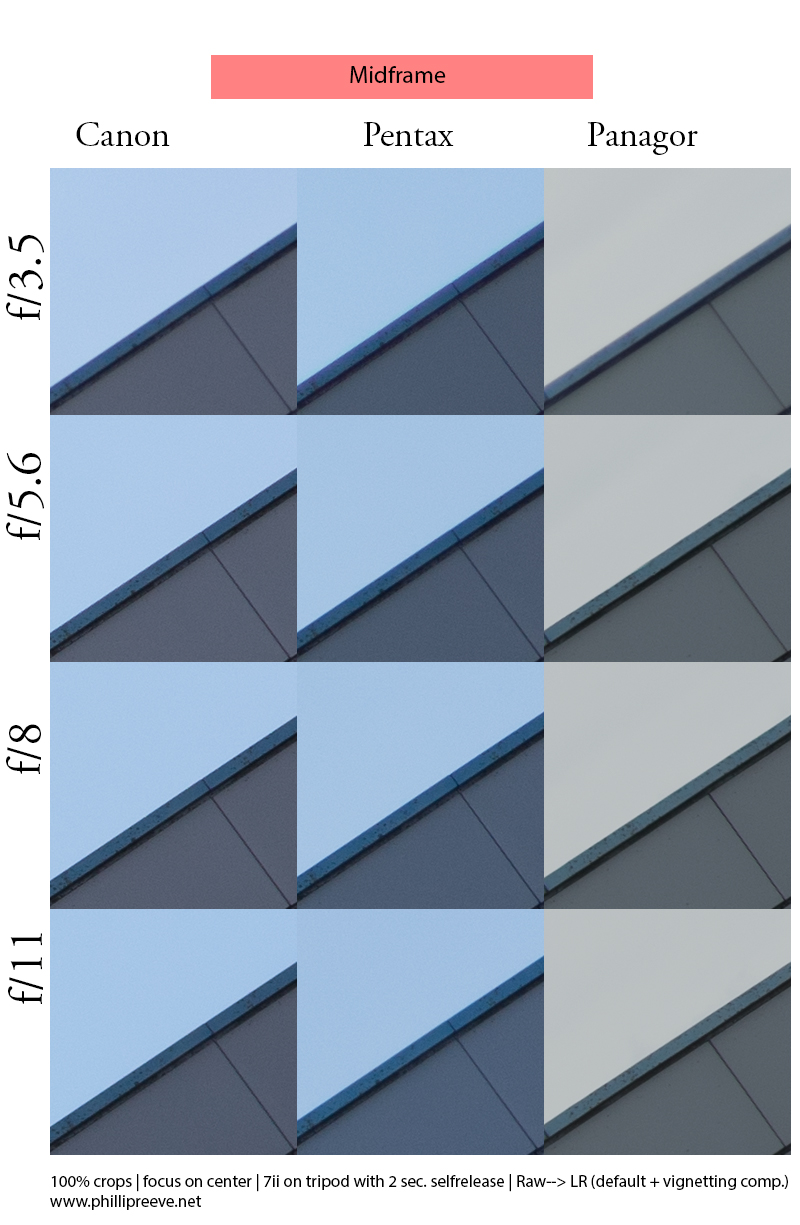
f/3.5 The Pentax looks best, Canon is second and the Panagor is the clear loser.
f/5.6 The Canon looks quite a bit better than the competition. The Pentax and Panagor look very similar.
f/8 The Canon has a little edge over the Pentax with the Panagor a little bit behind it.
f/11 Diffraction is visible and degrades image quality.

f/3.5 The Canon blows the competition away, the Panagor is clearly the worst.
f/5.6 More or less the same as at f/3.5
f/8 The Canon and Pentax are both excellent, difference is really small. The Panagor stays behind by quite some margin.
f/11 All three lenses are very comparable
The Canon newFD 135mm f/3.5 is the clear winner. Wide open across the frame sharpness is very good already and stopped down to f/5.6 sharpness across the frame is simply excellent. The SMC-Pentax-M 135mm f/3.5 performs quite similar in the center but is quite a bit weaker in the corners. Stopped down both lenses are excellent performers. The Panagor is significantly weaker, diffraction starts to kick in quite early in the center but the corners peak at f/11.

At typical portrait distances the Canon is visibly sharper too. The Pentax and Panagor show very similar performance. All lenses are plenty sharp to use wide open for this type of photography.
Vignetting
| Aperture | Canon | Panagor | Pentax |
| f/2.8 | – | 1.4 | – |
| f/3.5 | 1 | 1 | 1 |
| f/5.6 | 0.4 | 0.2 | 0.4 |
| f/8 | 0.2 | 0.2 | 0.3 |
| f/11 | 0.2 | 0.2 | 0.3 |
All lenses show a good performance here. Wide open there is some vignetting and already at f/5.6 vignetting is reduced to negligible levels. The Panagor performs best shortly followed by the Canon, the Pentax sits close behind the Canon. These differences are very small and not relevant in the field.
Bokeh

-

Canon newFD 135mm f/3.5 | f/3.5 -

Panagor PMC 135mm f/2.8 | f/2.8 -
 SMC Pentax-M 135mm f/3.5 | f/3.5
SMC Pentax-M 135mm f/3.5 | f/3.5
Bokeh is a very subjective topic and therefore I tried to make a few comparisons that help you find out what rendering you like the most.
I have a few personal criteria to asses the bokeh as good:
– The bokeh balls don’t have (much) outlining, this helps to get a calm background which I think is important.
– The cats eye effect (oval shaped bokeh balls towards corners) is not too pronounced, the swirl caused by the cat’s eyes draws attention away from the subject
-No onion rings, I think onion ring bokeh is very ugly.
Your view on the points above might vary, it’s only there to explain my assessment.
Taking the points above into account, the Canon has the best bokeh. It shows noticeably less outlining than the Pentax and Panagor, which results in smooth bokeh. The Panagor and Pentax show a significant amount of green bokeh fringing, the Canon is not free of green fringing either but it is much less pronounced.
The Pentax and Canon both show a slight cat’s eye effect, but nothing obtrusive. The Panagor however shows more pronounced cat’s eyes, therefore bokeh can be a bit busy towards the edges. None of the lenses shows onion rings, a result of their simple optical designs devoid of any aspherical elements.
-
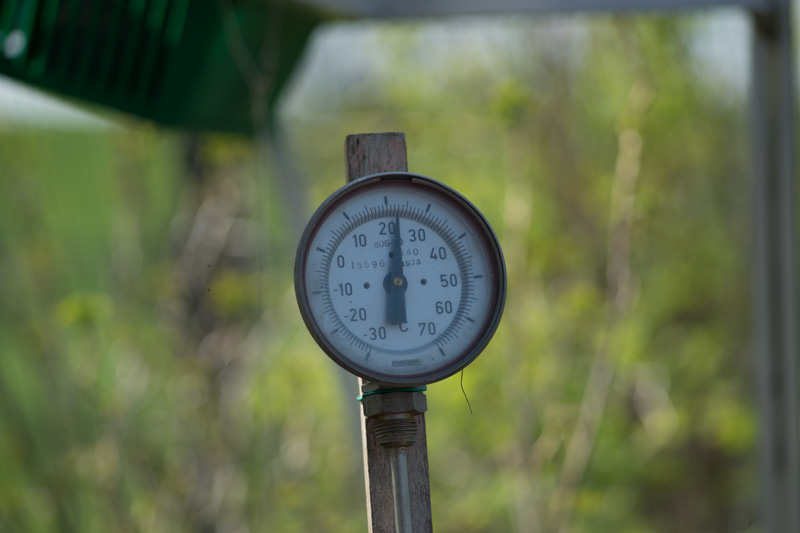
Canon newFD 135mm f/3.5 | f/3.5 -
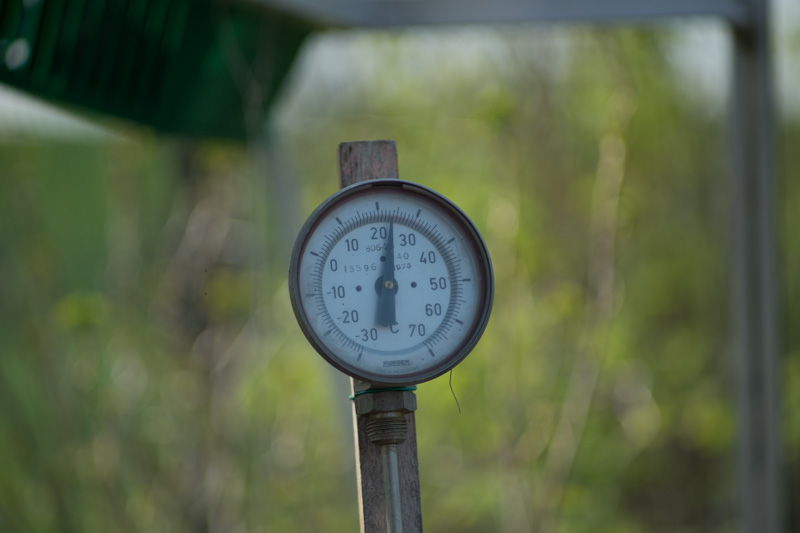
Panagor PMC 135mm f/2.8 | f/3.5 -

SMC Pentax-M 135mm f/3.5 | f/3.5
-
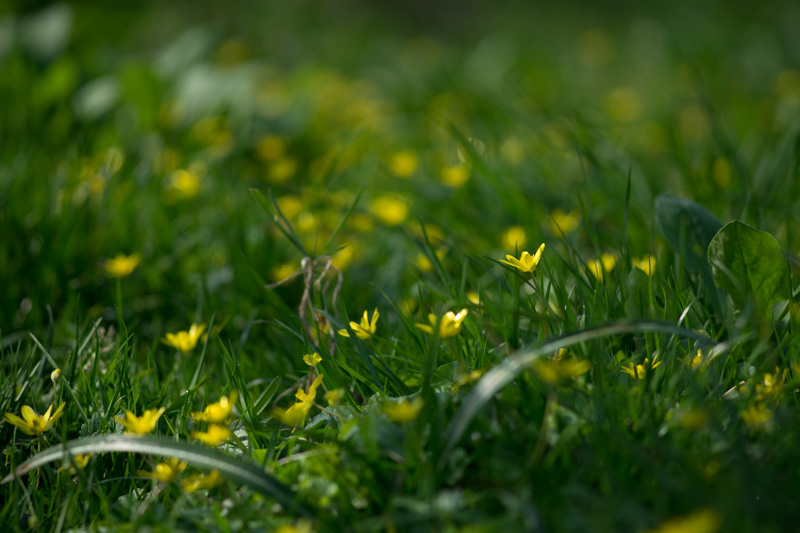
Canon newFD 135mm f/3.5 | f/3.5 -
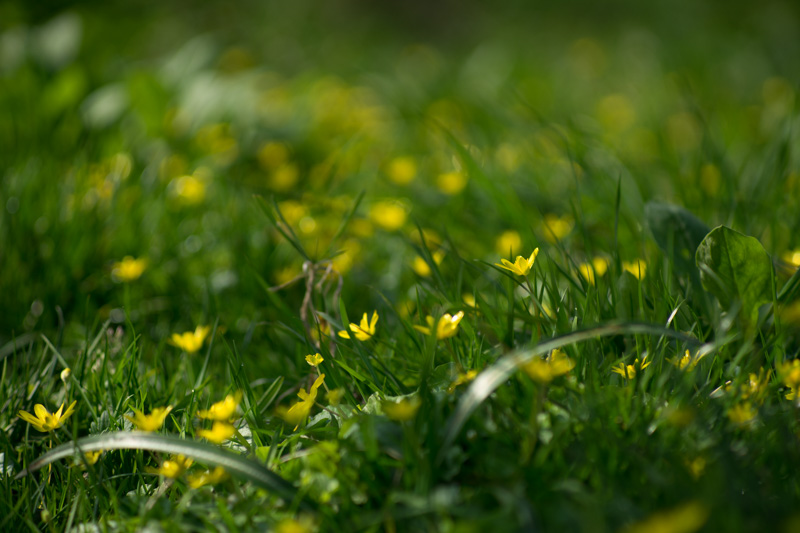
Panagor PMC 135mm f/2.8 | f/3.5 -

SMC Pentax-M 135mm f/3.5 | f/3.5
-

Canon newFD 135mm f/3.5 | f/3.5 -

Panagor PMC 135mm f/2.8 | f/3.5 -

SMC Pentax-M 135mm f/3.5 | f/3.5
Flare resistance
Sun in the frame (f/8)
-

Canon nFD 135mm f/3.5 | f/8 -

Panagor PMC 135mm f/2.8 | f/8 -

Pentax SMC Pentax 135mm f/3.5 | f/8
With the sun in the frame the Pentax performs clearly better than the competition. The Canon shows quite some colorful artifacts around the sun, the Panagor has a large blue flare around the sun. Note that there were some dust spots on the elements of the Canon, these are causing the grey spots right from the sun and make things look worse than they actually are.
-

Canon nFD 135mm f/3.5 | f/8 -

Panagor PMC 135mm f/2.8 | f/8 -
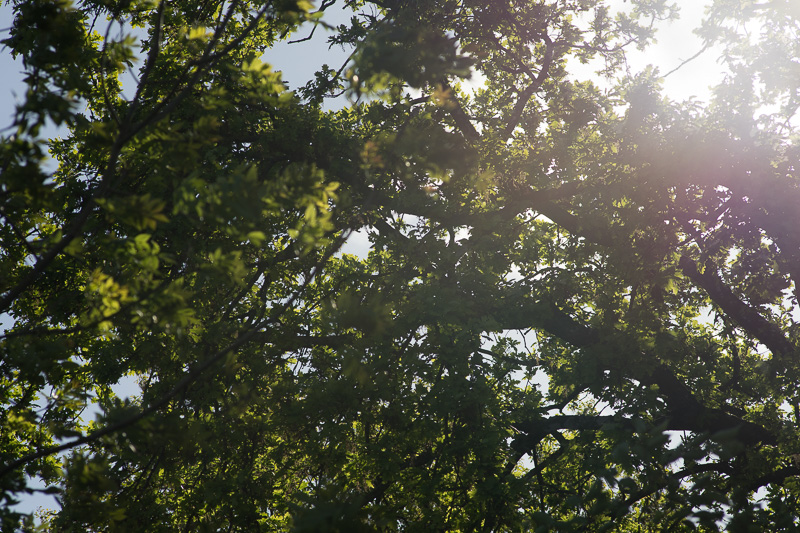
Pentax SMC 135mm f/3.5 | f/8
With the sun just outside the frame things look different, the Canon shows the least veiling flare of these lenses and I think this is a good performance especially considering the age of the lens. The Panagor shows a huge flare across most of the frame that ruins the image. The Pentax shows a purple veiling flare but as it decreases gradually towards the center it is not as obtrusive as the flare of the Panagor.
None of these lenses has very good flare resistance, the Pentax is a bit better than average with the sun in the frame, and the other two show an average performance here. With the sun just outside the frame the Canon performs above average, the others are average here.
Chromatic aberrations

Wide open the Panagor shows significant purple fringing, the Canon and Pentax only show minor fringing which usually isn’t much of a problem.
-

CA f/8 -

f/8
All three lenses show some LaCA in the extreme corners stopped down. The Panagor performs the best here, the Canon and Pentax show a bit more LaCA and seem to be comparable to each other in the uncorrected files. However, the LaCA of the Pentax is very hard to correct since it is no hard edge but it “bleeds”. This makes the Canon a better performer in this regard.
The lenses show some CA but nothing too obtrusive. I would rate this performance about average. I think the Canon performs best here when taking the different kinds of CA into account. The Pentax is the worst in this regard I think as LaCA is very hard to correct with this lens.
Conclusion
All three lenses are capable and can deliver excellent images. Still, there are significant differences between them. More different than I expected. The Canon outperforms the Pentax and Panagor in most aspects. It is much sharper with more even sharpness across the frame than the competition. Also the bokeh of the Canon looks best to me due to only minor outlining and bokeh fringing.
I tried to score the lenses from 1 (best) to 3 (worst) in the categories discussed above to give you an idea how the lenses compare (yes it is a bit subjective 😉 ).
| Category | Pentax | Panagor | Canon |
| Build quality & handling | 1 | 3 | 2 |
| Sharpness | 2 | 3 | 1 |
| Bokeh | 3 | 2 | 1 |
| CA | 3 | 2 | 1 |
| Flare resistance | 1 | 3 | 2 |
| Vignetting | 3 | 1 | 2 |
| Average | 2.2 | 2.5 | 1.5 |
I think the Canon is the most rounded lens. Speed, performance and size are balanced well which makes the lens a joy to use.
The Pentax also is a good lens, but I think making it so small had a negative impact on image quality. Sharpness could have been better and bokeh was on the busy side sometimes.
The Panagor performs better than I expected, but I think it is significantly weaker than the Pentax and especially the Canon. Sharpness is not great, bokeh can be busy and it is a bit too heavy for my taste.
So what lens to pick?
If size and weight aren’t too important the Canon is the lens of my choice, image quality is simply the best. I decided to keep the Canon newFD 135mm f/3.5 as my main tele lens for now.
If size and weight are important to you, and the not so great across the frame sharpness is something you can live with the little Pentax is a good option. I decided to keep it for the trips where size and weight really count.
Is there any reason to get the Panagor PMC 135mm f/2.8? Yes, if you find one cheap it is fun to have and it will deliver nice pictures. But at it’s usual price I would rather get the Pentax which is cheaper.
All three lenses can be found in good condition for around 50$/€
Canon: Ebay.com* | Ebay.de*
Pentax: Ebay.com* | Ebay.de*
Panagor: Ebay.com* | Ebay.de*
(*Affiliate links, if you buy something via this link I will earn a small commission and it doen’t cost you anything extra 🙂 )
Further reading
REVIEW: SONY FE 135MM F1.8 GM
REVIEW: CANON new FD 2.8/135
REVIEW: LEICA APO-TELYT-M 135MM 3.4
QUICK REVIEW: JUPITER-11 135MM 4.0
REVIEW: ZEISS BATIS APO SONNAR T* 135MM F2.8
REVIEW: SAMYANG 2/135 ED UMC
REVIEW: MS-OPTICS APORIS 135MM 2.4 FLUORIT MC
REVIEW: CANON EF 135MM 2.0L – THE LORD OF THE RINGS ON SONY A7RII
This site contains affiliate links. If you make a purchase using any of the links marked as affiliate links, I may receive a small commission at no additional cost to you. This helps support the creation of future content.
JuriaanM
Latest posts by JuriaanM (see all)
- Review: Sigma 85mm f/1.4 DG DN Art - January 8, 2022
- A beginners guide to landscape astro photography - March 11, 2021
- Canon newFD 50mm f/1.8: A review - January 4, 2021
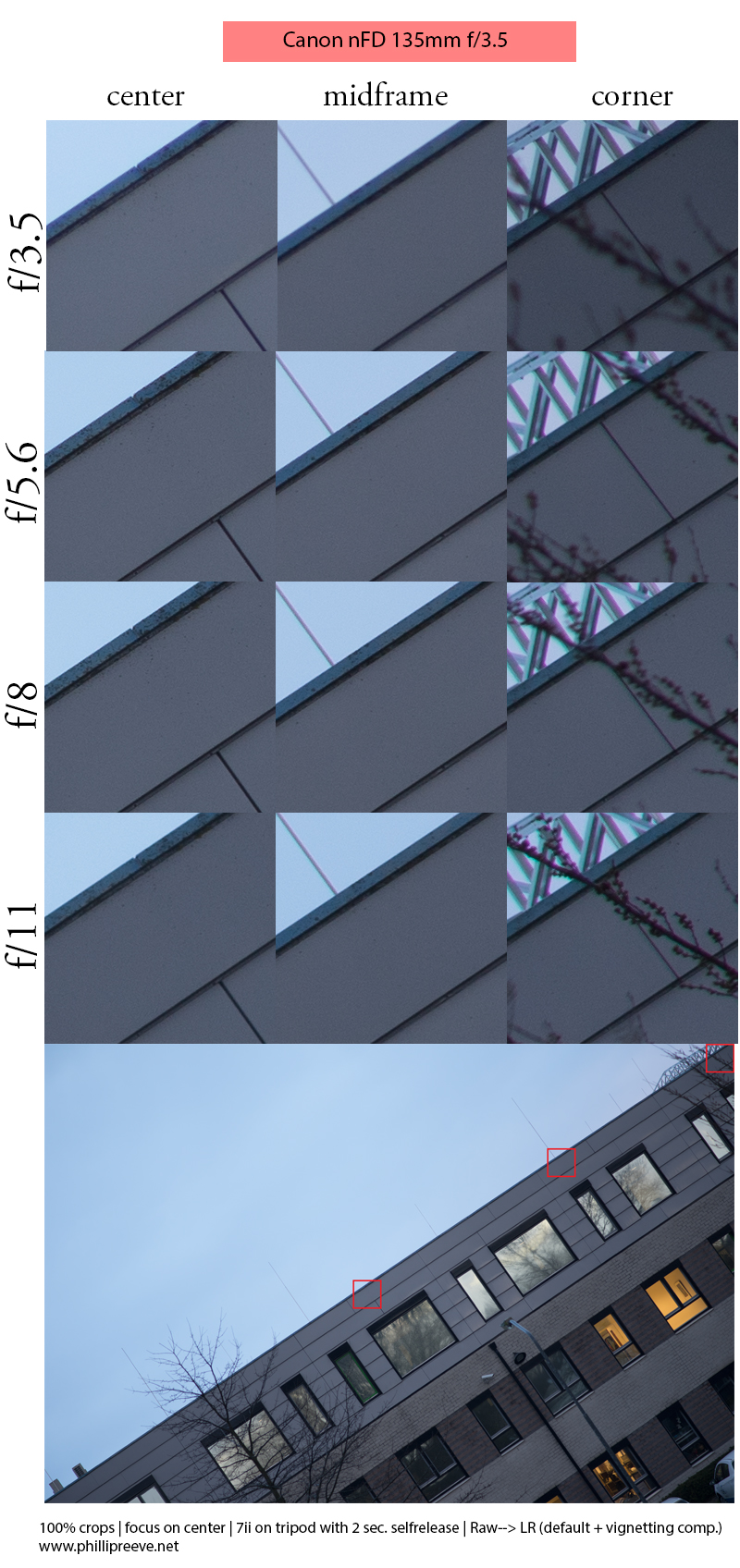



Hi, thank you for you nice review. Ever thought about the canon 135mm ltm? In my opinion also a good option.
https://www.pebbleplace.com/reviews/rangefinder/canon_135mm_ltm/index.html
Looks like an interesting option as well! I never came across one cheap until now, but if I find one I might test it 🙂
The M Pentax isn’t as good as the K. I have the earlier K and it is pretty darn sharp. They sacrificed IQ to both save money and size for the M version. The 3.5 is very good. You may have a less than optimal copy too.
I have tested two different samples and both performed identically 🙂 Nevertheless it is still a good lens!
Agreed. The older ‘non M’ Pentax lenses, often indicated as ‘K’ series, are generally better than the M and A series (with some exceptions). Some are in fact optically the same as the Takumars, but with even better coatings (front and back of the elements coated). You can see they were still a premium brand, trying to compete with Nikon and Canon. With the M line of lenses, they became more average quality. Very compact and light though. I have had probably between 50 and 100 Pentax lenses, and I can say the Takumars have the best build quality, followed by the K series.
The grease they used in the Takumars is the best I have ever encountered. I have never experienced a Takumar with stiff focus or aperture ring. And usually no fungus or haze either. In contrast, I’ve seen an incredible amount of Nikkors, Canons and even Leica lenses with these issues. Pentax K lenses sometimes have issues, but Takumars are incredible pieces of engineering, with the best build quality ever made.
Thanks for this review. I’m in the market for a light/small tele for my ultra light travel kit, where the FE55 is currently my longest lens. I’m planning on getting the Olympus OM 100/2.8 or Minolta MD 100/2.5, but a 135 would give even more reach. I have the Minolta MD 135/3.5, but it’s a bit soft, and I don’t always want to stop down to 5.6 or 8, which makes hand-held shooting tough unless conditions are perfect. I’d be curious to know how much sharper the Canon is. The bit of extra weight for sharpness might be worthwhile. Thanks again!
Juriaan, thanks for an excellent comparison. I like especially the set of bokeh comparison images — beautifully made and covered a wide user scenarios.
I think the CZJ 135/3.5 also fit in the category of lightweight, vintage and cheap 135mm lenses. The resolution and CA control is great. Flare is on the high side though.
BTW I would like to have a comparison after lateral CA is removed, to better check their corner resolution.
Thank you! There is a tab in the LaCA section so you can see how it looks with correction on 😉
Thanks. In that section I noticed the Canon, although showing quite good corner in the sharpness section, seems to have strong astigmatism in the LoCA section with LoCA removed.
Nice comparison, I agree, and also Haitong’s comment regarding the CZJ 135/3,5, if for another reason: it’s mfd of 1m, it makes a significant difference for how I shoot compared to other 135mms.
Hello,
Good article. It is nice to compare some old goodies and it is done very well here.
I just wonder why not one of the Nikon’s manual 135mm lenses is included?
Nikkor AI-s 135mm f/2.8 or AI-s 135mm f2 or 135mm f/3.5.
In some other forums these lenses are praised and adored for their build and optical quaility but never any mention of them here.
Regards,
/MH
The Nikkors are a bit more expensive and I never come across those cheap so I have no experience with them (Budget is tight haha). I my 35mm Nikkor is a good representative of older Nikon lenses they will be certainly good.
As Zos Xavius indicated, the older Pentax 135mm f/2.5 was, as I recall, regarded as generally superior to the later f/2.8 and f/3.5 iterations except for weight. A thief left that lens behind when he cleaned out the rest of my Pentax and Mamiya kit, but I haven’t used it in years.
My own experience with “light” 135mm lenses:
Pentax M 135 3.5 < Olympus OM 135 3.5 < Zeiss Jena 135 3.5 MC < Leica M Tele-Elmar 135 4.0 (not that light, but very sharp).
Thank you for sharing your experiences 🙂
where is canon
Thanks for the review. I hope to see more often 😉
If MS-optics 135 2.4 was tad cheaper, I’d use that lens because of the weight and its contrast. Vintage slower 135 lenses were appealing, but I ended up with EF 135 F2L. I thought 135 is a little too short for “I don’t care the F-stop, because I need only the reach.”
I like my Leica R 135/2.8
The difference probably does not show when shot handheld due to the shutter speed issue.
I have got a copy of the first version, SMC PENTAX 135mm f3.5, not pentax-m; uploaded some casually shot samples to the flicker:
https://www.flickr.com/photos/163756246@N03/sets/72157708443126495
I tried to see the difference but the handheld shots were too bury for pixel peeping to draw any conclusion.
Apart from 2 obviously vivid photos, the others have most post processing options like sharpness turned off and developed in darktable.
K series SMC PENTAX 135mm f3.5:
+ CA issues remain as the m version but supposedly has less of it.
+ Sharpness: pentax forum claims significantly better.
+ 365 g
+ Filter Size: 52 mm
Personally I like a macro lens or a 200mm prime than a 135mm for generally speaking they tend to be either better or more versatile for the price.
Thanks for the comparison. Juriaan you are my man here, please keep reviewing affordable old glass and not only 1000 € Lenses, which I never can afford (nice to dream of).
I have the Minolta MD Tele Rokkor 2.8/135mm und the CJZ Prakticar 3.5/135mm. The Minolta is sharper from wide open, but heavy, has a long minimal focus distance and suffers from purple fringing. The Prakticar is smaller, has better CA-correction and better minimal focus distance (1m) but (my sample) cannot compete in sharpness.
My budget is tight so the lenses I review will be not that expensive 🙂 Thank you for sharing your experience. I hear a lot about that CJZ 135mm, I will try to find one cheap I think.
If you want to review CJZ 3.5/135mm better get at least three of them for review, they have huge sample variation. If shipping to the Netherlands is not more expensive than the lens itsself, I could borrow you mine for review, just to have another sample, I don’t use it often.
Hey Juriaan,
Thanks for this review based on this I got the canon lens from eBay and was pleasantly surprised how well it stood up to other more modern and expensive lenses that I have. You have opened up to me to a whole world of legacy and manual lenses ? that don’t break the bank.
Thanks.
Thanks for the review. Better Canon 135 f2.8 or f3.5? Thank you.
I have used Minolta MD 135/3.5 for over 30 years
First on Minolta X-500 and then on Sony cameras.
Think Minolta MD lenses are generally better built then Canon nFD….I have a lot of nFD and MD lenses to compare. I think the differences are very small between them for daily normal photography except for the build quality where Minolta wins..
Thanks for the great comparison you guys are making a wonderful contribution. I have the FD 135 f2.8. I note that the f3.5 is lighter but is the f3.5 otherwise superior to the f2.8. They’re not expensive so I would be willing to try the f3.5 if you thought they’d be any point. Thanks for the advice.
thanks for the test. Very useful.
One thing on the Pentax, the M135 f3.5 is a well know to perform better on APSC sensor while the M120 f2.8 is a better performer on FF.
What a great article. Cogent, well written, thorough. I am. Very, very impressed. I have added to my favorites. Thank you very much.
Your final weighting seems at odds with your text? Did you get the column headings correct?
My bad, I just realized you give 1 point for best and 3 for worst so the lowest score wins… somewhat counter-intuitive?
Your final weighting seems at odds with your text? Did you get the column headings correct? Just realized you give the lowest score for the best result. Somewhat counter-intuitive?
The Nikkor q 135 3.5 are fairly cheap. Bought mine for $35. Got lucky found one ai converted. Stick with the more common 6 or 7 bladed versions. The early ones have more blades and are more valued by serious collectors.
Has anyone tried the Konica Hexanon AR 135mm f/3.5 (f/22 made in Japan version)? How would it compare to these ones?
I had a hexanon AR 135mm 3.5 at some point. It at least looked like the f22 version but I can’t say for sure.
I really enjoyed the size and weight of it and it would have been rather nice to keep, but it wasn’t that sharp at 3.5 and it didn’t improve that much when stopping down. I think it’s closer to the panagor in this comparison than anything else.
I compared it with the tokina RMC 135 2.8 and zeiss cy 135 2.8 which I had at the time. I remember it being the worst of them optically but also the lightest.
(Sorry for a late comment). There are indeed two versions of the Panagor. I have a Panagor 135mm f.2.8 for Nikon nonAI, Non PMC – with 8 apertures blades. The weight is 430gr w/o caps. The hood is tight and perfect – not like your copy. It has yellow feet distance marks – and there is no red PMC stamp in the front. I could only find one similar on ebay (link below).
https://www.ebay.com/itm/385228723145?mkcid=16&mkevt=1&mkrid=711-127632-2357-0&ssspo=bknh6onxrao&sssrc=2047675&ssuid=&widget_ver=artemis&media=COPY
I bought the Pentax-M 135mm f/3.5 in perfect condition for 5€(!). Once you know its strengths and weaknesses it’s a great lens to r take for a hike. Just don’t take landscape images wide open. Good contrast and colors, effective coatings, good build quality, 8 aperture blades.